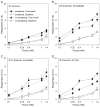Exercise-induced pain requires NMDA receptor activation in the medullary raphe nuclei
- PMID: 21795998
- PMCID: PMC3955196
- DOI: 10.1249/MSS.0b013e31822f490e
Exercise-induced pain requires NMDA receptor activation in the medullary raphe nuclei
Abstract
Purpose: Pain in response to physical activity is common in people with chronic musculoskeletal pain and is likely a barrier to regular exercise, which would lead to a sedentary lifestyle. We recently developed a model of exercise-induced pain that is associated with increased activation of neurons in the medullary raphe nuclei, i.e., the nucleus raphe obscurus (NRO) and nucleus raphe pallidus (NRP). Because the NRO and NRP not only modulate motor output but also respond to noxious stimuli, we hypothesized that the NRO and NRP were key nuclei in the interaction between pain and exercise. We tested whether exercise enhances hyperalgesia through activation of N-methyl D-aspartate (NMDA) receptors in the NRO/NRP.
Methods: Muscle insult was induced by two injections of pH 5.0 saline 5 d apart into one gastrocnemius muscle. We initially tested whether hyperalgesia developed in mice injected with acidic saline (pH 5.0) into the gastrocnemius muscle immediately after a 30-min or 2-h exercise task or 2 h after a 2-h exercise task. Next, we tested whether blockade of NMDA receptors in the NRO/NRP during the exercise task prevented the development of exercise-induced hyperalgesia. Finally, we evaluated changes in phosphorylation of the NR1 subunit of the NMDA receptor (pNR1) after the exercise task at times in which muscle insult was given in behavioral experiments, i.e., immediately after a 30-min or 2-h exercise task or 2 h after the 2-h exercise task.
Results: All exercise conditions enhanced nociception (hyperalgesia) after combining with two injections of pH 5.0 saline. Microinjection of AP5 (1.0-0.1 nmol; 2-amino-5-phophonopenanoate) dose-dependently prevented the development of exercise-induced hyperalgesia. All exercise conditions increased pNR1 in the NRO and NRP.
Conclusions: Thus, exercise-induced pain in sedentary mice is associated with increased phosphorylation and activation of NMDA receptors in the NRO/NRP, suggesting that changes in central excitability mediate an interaction between unaccustomed exercise and pain.
Conflict of interest statement
There is no conflict of interest for Kathleen A. Sluka, Jessica Danielson, Lynn Rasmussen, or Luis Felipe DaSilva. The authors have declared that no competing interests exist.
Figures





Similar articles
-
Activation of NMDA receptors in the brainstem, rostral ventromedial medulla, and nucleus reticularis gigantocellularis mediates mechanical hyperalgesia produced by repeated intramuscular injections of acidic saline in rats.J Pain. 2010 Apr;11(4):378-87. doi: 10.1016/j.jpain.2009.08.006. Epub 2009 Oct 22. J Pain. 2010. PMID: 19853525 Free PMC article.
-
Regular physical activity prevents development of chronic pain and activation of central neurons.J Appl Physiol (1985). 2013 Mar 15;114(6):725-33. doi: 10.1152/japplphysiol.01317.2012. Epub 2012 Dec 27. J Appl Physiol (1985). 2013. PMID: 23271699 Free PMC article.
-
Activation of protein kinase C in the spinal cord produces mechanical hyperalgesia by activating glutamate receptors, but does not mediate chronic muscle-induced hyperalgesia.Mol Pain. 2006 Apr 3;2:13. doi: 10.1186/1744-8069-2-13. Mol Pain. 2006. PMID: 16584564 Free PMC article.
-
Effects of NMDA and non-NMDA ionotropic glutamate receptor antagonists on the development and maintenance of hyperalgesia induced by repeated intramuscular injection of acidic saline.Pain. 2002 Jul;98(1-2):69-78. doi: 10.1016/s0304-3959(01)00471-7. Pain. 2002. PMID: 12098618
-
Does exercise increase or decrease pain? Central mechanisms underlying these two phenomena.J Physiol. 2017 Jul 1;595(13):4141-4150. doi: 10.1113/JP273355. Epub 2017 May 26. J Physiol. 2017. PMID: 28369946 Free PMC article. Review.
Cited by
-
Pain management in hemophilia: expert recommendations.Wien Klin Wochenschr. 2021 Oct;133(19-20):1042-1056. doi: 10.1007/s00508-020-01798-4. Epub 2021 Mar 4. Wien Klin Wochenschr. 2021. PMID: 33661391 Free PMC article. Review.
-
Neurobiology of fibromyalgia and chronic widespread pain.Neuroscience. 2016 Dec 3;338:114-129. doi: 10.1016/j.neuroscience.2016.06.006. Epub 2016 Jun 9. Neuroscience. 2016. PMID: 27291641 Free PMC article. Review.
-
Assessment of avoidance behaviors in mouse models of muscle pain.Neuroscience. 2013 Sep 17;248:54-60. doi: 10.1016/j.neuroscience.2013.05.058. Epub 2013 Jun 7. Neuroscience. 2013. PMID: 23747349 Free PMC article.
-
Animal models of fibromyalgia.Arthritis Res Ther. 2013;15(6):222. doi: 10.1186/ar4402. Arthritis Res Ther. 2013. PMID: 24314231 Free PMC article. Review.
-
Forced treadmill running reduces systemic inflammation yet worsens upper limb discomfort in a rat model of work-related musculoskeletal disorders.BMC Musculoskelet Disord. 2020 Jan 30;21(1):57. doi: 10.1186/s12891-020-3085-z. BMC Musculoskelet Disord. 2020. PMID: 32000751 Free PMC article.
References
-
- Bement MK. Exercise-induced hypoalgesia: an evidence-based review. In: Sluka KA, editor. Mechanisms and Management of Pain for the Physical Therapist. Seattle (WA): IASP Press; 2009. pp. 143–66.
-
- Cerne R, Jiang M, Randic M. Cyclic adenosine 3′5′-monophosphate potentiates excitatory amino acid and synaptic responses of rat spinal dorsal horn neurons. Brain Res. 1992;596:111–23. - PubMed
-
- Coutinho SV, Urban MO, Gebhart GF. Role of glutamate receptors and nitric oxide in the rostral ventromedial medulla in visceral hyperalgesia. Pain. 1998;78:59–69. - PubMed
Publication types
MeSH terms
Substances
Grants and funding
LinkOut - more resources
Full Text Sources
Miscellaneous

